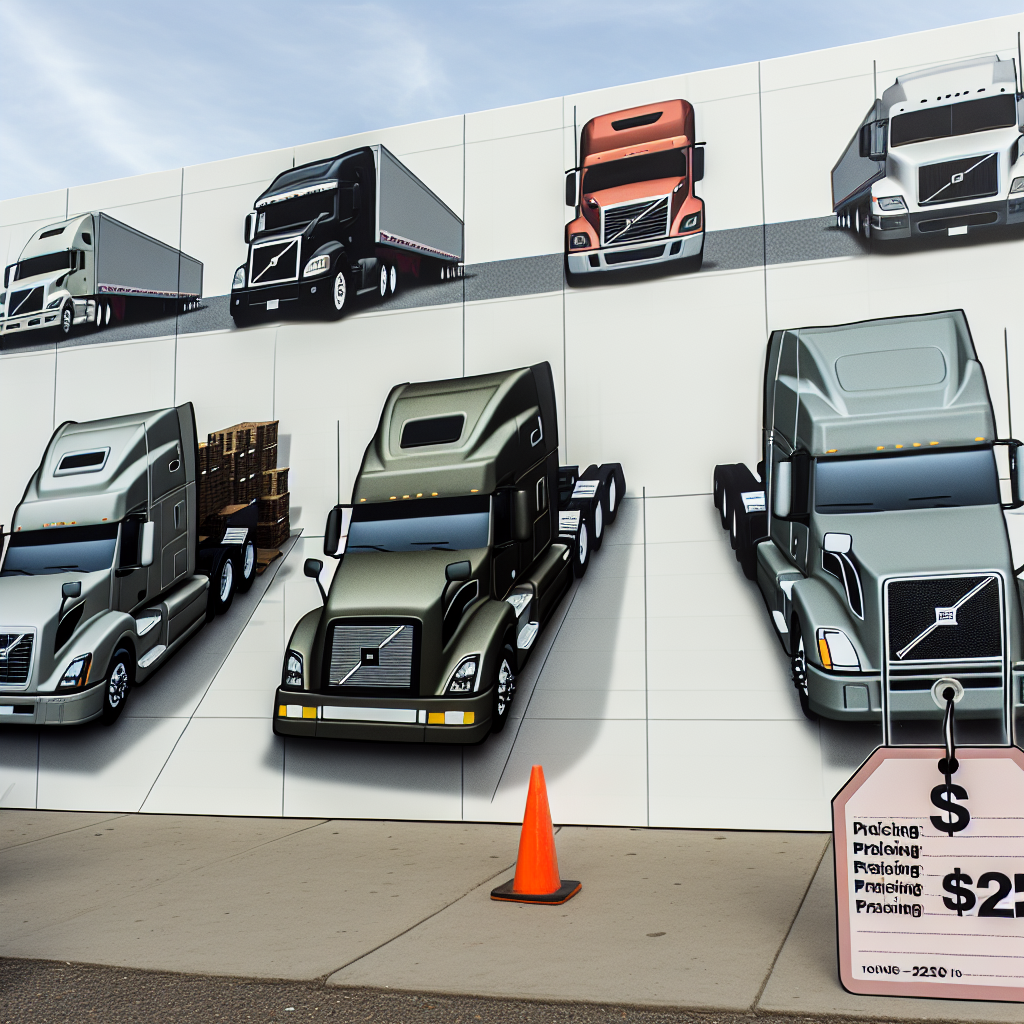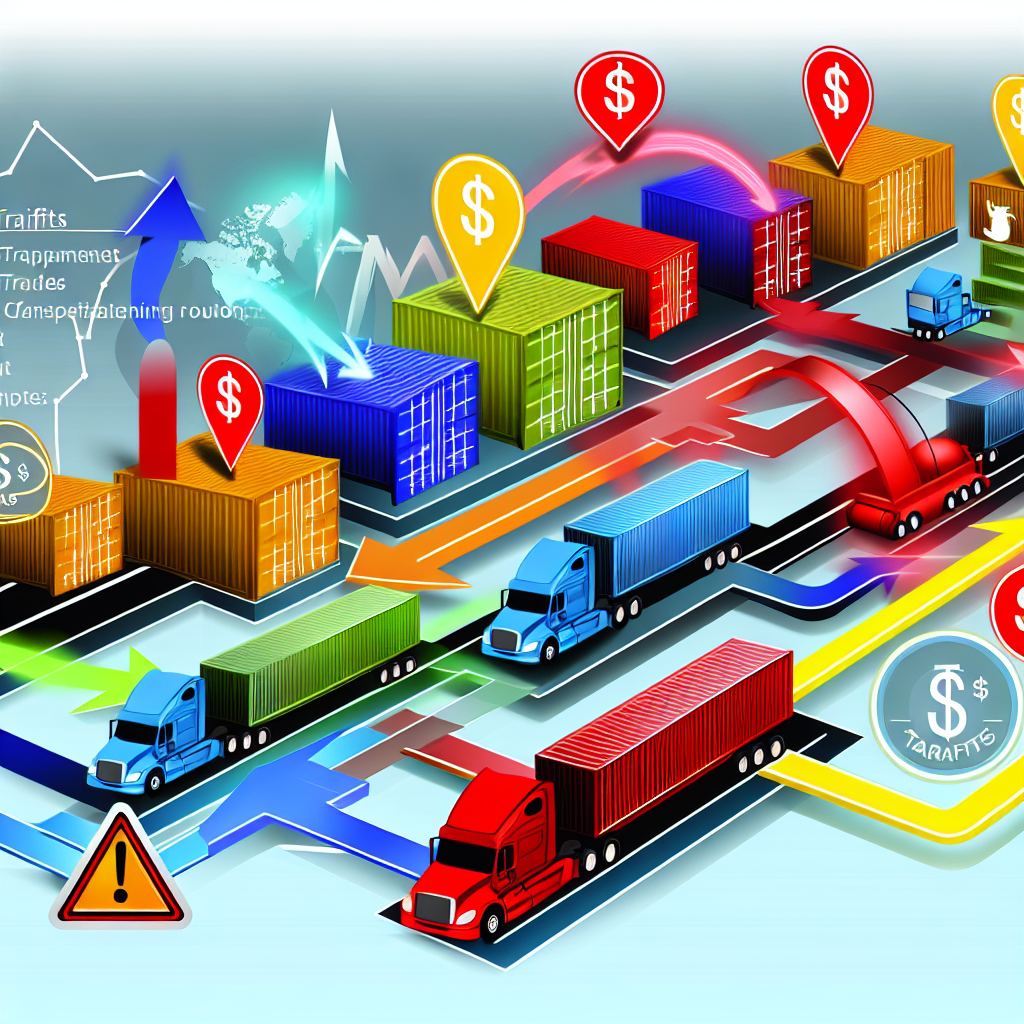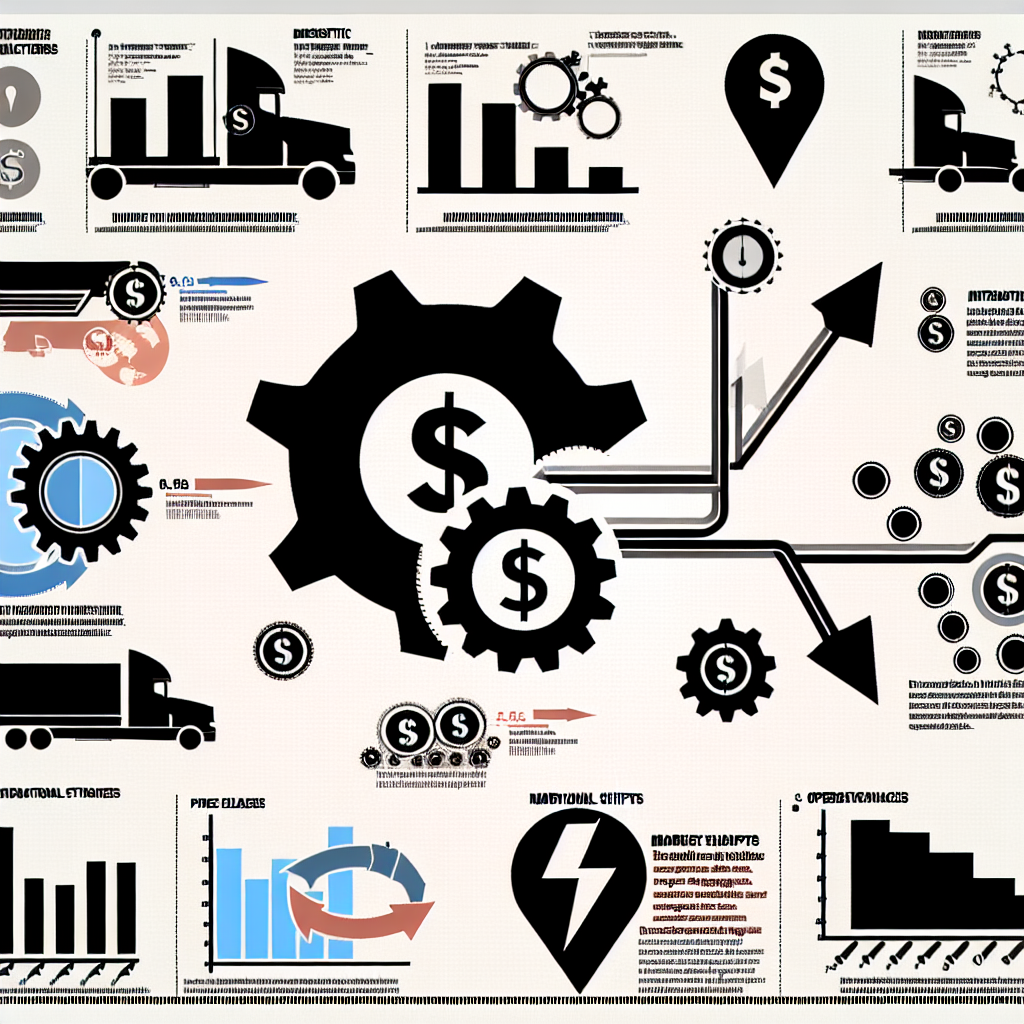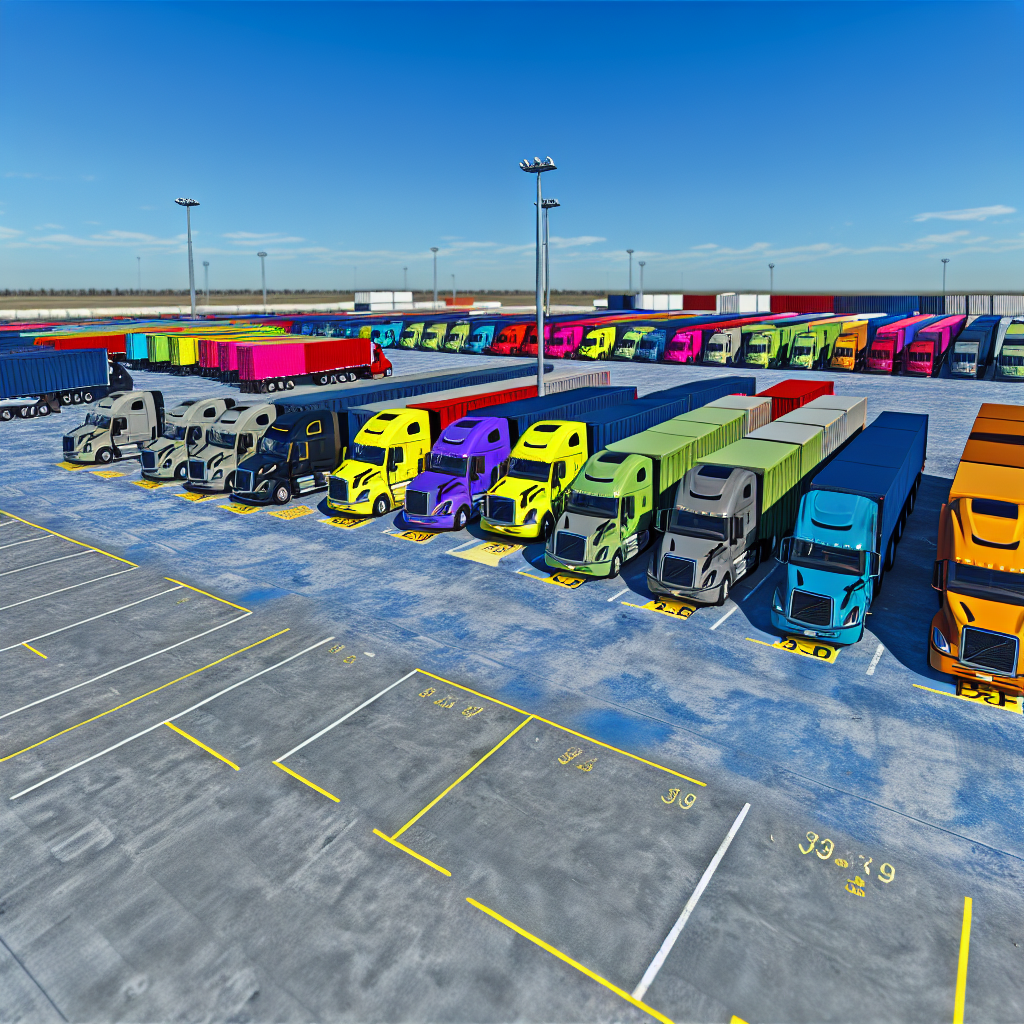The recent implementation of a 25% tariff on heavy trucks not manufactured in the United States marks a critical juncture for the trucking industry and the broader economy. Announced by President Donald Trump, this tariff was underscored by concerns over national security and aims to bolster domestic manufacturers such as Mack Trucks and Paccar. Effective October 1, 2025, this significant tariff has triggered a wave of uncertainty across the logistics and transportation sectors, challenging the established supply chains and pricing strategies that many companies have relied on for years.
As import costs rise, the implications for truck prices are steep. The market is likely to see an increase of up to 25% in the cost of foreign-made trucks, potentially leading to higher freight costs that may be passed on to consumers. This development follows a national security investigation that concluded such tariffs were necessary to protect American jobs and industry. Accusations of unfair competition have emerged, particularly with allegations that foreign manufacturers are subsidized by their governments.
Moreover, the economic apprehensions extend beyond mere pricing strategies for trucking companies. The ripple effects on logistics providers and shippers are profound, as they navigate the complexities of operating in a tighter market with fewer cost-effective options. Companies have reacted with varying strategies to adapt to this new landscape, underscoring the need for flexibility within their supply chains. With service interruptions and changing freight volumes, the stakes are high, illustrating the interconnected nature of tariffs and the trucking market’s performance.
In this article, we will delve into the ramifications of these tariffs, exploring how different sectors within the trucking industry respond to these challenging mandates and what it means for the future of U.S. transportation.


Impact of 25% Tariff on the Trucking Market
The implementation of a 25% tariff on heavy trucks not built in the United States is set to create ripple effects throughout the trucking industry. Here is a detailed analysis of the anticipated impact on pricing, market dynamics, and manufacturers.
Price Increases
- Expected Price Hikes: Analysts project that the average MSRP (Manufacturer’s Suggested Retail Price) for heavy trucks could increase by approximately $25,000 to $35,000 due to the tariffs. This estimate reflects the addition of the tariff cost to the price of trucks that are imported into the U.S. (Allyn International).
- Cost Pass-Through: Trucking companies may opt to pass these increased costs onto consumers, leading to higher freight rates. This could exacerbate inflationary pressures in other sectors reliant on transportation.
Shifts in Market Dynamics
- Supply Chain Disruptions: The tariffs are likely to disrupt existing supply chains, forcing companies to re-evaluate their sourcing and transportation strategies. Imported trucks which were once cost-effective may become less accessible, prompting a shift towards domestic options, albeit at a higher cost (Headwall Logistics).
- Logistical Challenges: Businesses may face increased logistical challenges, including potential delays in truck availability, as U.S. manufacturers ramp up production to fill the void left by diminished foreign imports. These adjustments could lead to inefficiencies in operations for many logistic providers.
Effects on Domestic vs International Manufacturers
- Domestic Manufacturers: Companies like Paccar (which includes well-known brands like Peterbilt and Kenworth) stand to benefit from diminished competition from international truck manufacturers. With less pressure from imports, domestic companies might improve their profitability and market share (Solowp).
- International Manufacturers: Companies such as Daimler and Traton may face significant challenges, including reduced sales in the U.S. They may be compelled to adjust their pricing strategies and possibly seek alternative markets to maintain profitability (Automotive Logistics).
Overall Industry Implications
- Impact on Industry Stability: The American Trucking Associations (ATA) has voiced concerns that such tariffs could worsen the industry’s ongoing “freight recession,” potentially driving smaller carriers out of the market due to increased operating costs and tighter profit margins. This may lead to a consolidation in the industry, reducing competition further (Automotive Logistics).
- Future Market Outlook: With anticipated capital tightness and increased truck prices, the overall growth potential of the trucking industry may be compromised in the face of rising input costs and tariff-related uncertainties.
| Manufacturer | Market Share (%) | Potential Reactions to Tariffs |
|---|---|---|
| Mack Trucks | 15 | May increase production capacity to meet demand, potentially raising prices. |
| Volvo | 12 | Likely to adapt pricing strategies, perhaps looking to cut costs elsewhere. |
| Paccar | 20 | Likely to benefit from increased domestic sales, might invest in marketing. |
| Peterbilt | 10 | Expected to see increase in sales due to reduced competition from imports. |
| Kenworth | 8 | May enhance service offerings to attract more domestic clients. |
Challenges Facing the Trucking Industry Due to Tariffs
The trucking industry is currently facing significant challenges due to the recent implementation of a 25% tariff on medium- and heavy-duty trucks, effective November 1, 2025. This decision, highlighted by President Donald Trump, serves to protect domestic manufacturers from foreign competition, particularly impacting those imports from Mexico, which comprise a substantial share of the U.S. market.
As a response, manufacturers such as Paccar, Daimler Truck, and Volvo are re-evaluating their operational strategies. For instance, Paccar anticipates substantial tariff costs, around $75 million for the third quarter of 2025, prompting the company to scrutinize its supply chain logistics more closely. Companies with substantial manufacturing facilities in Mexico, like Stellantis and Volvo, are adjusting logistics to remain compliant with the US-Mexico-Canada Agreement (USMCA), thus mitigating some tariff impacts by qualifying for duty-free benefits on components sourced from North America.
Logistics companies are also adjusting to the new tariff landscape. The American Trucking Associations (ATA) has voiced concerns that these tariffs could lead to decreased freight volumes, significantly raising operational costs. In a rapidly changing environment, about 69% of U.S. logistics firms have reported needing to alter their business operations. This includes a pivot to domestic sourcing and warehousing to cope with potential delays and cost surges from international shipments.
Moreover, the market dynamics have shifted due to rising costs associated with metal tariffs on steel and aluminum derivatives, compelling manufacturers to explore alternative sourcing strategies. The expected price escalation for imported trucks may increase the cost of a new tractor by approximately $35,000, creating financial strain that could force smaller carriers out of business.
Overall, this evolving tariff situation has triggered extensive reevaluations across the trucking and logistics sectors. Companies must navigate the twin challenges of protecting profit margins while adjusting to fluctuations in consumer pricing and operational costs, leading to a potentially consolidated industry landscape as competition heats up and smaller operators struggle to keep pace with rising expenses.
Industry Leaders’ Insights on 25% Tariff on Imported Heavy Trucks
Donald Trump, President of the United States:
On September 25, 2025, President Trump stated, “In order to protect our Great Heavy Truck Manufacturers from unfair outside competition, I will be imposing… a 25% Tariff on all ‘Heavy (Big!) Trucks’ made in other parts of the World.” His emphasis on national security and support for U.S. manufacturers set the groundwork for the tariffs affecting the market.
source
Chris Spear, President & CEO of the American Trucking Associations (ATA):
Spear highlighted the potential repercussions of the tariffs, noting, “Trucks will be more expensive when we can least afford it.” He also cautioned, “The trucking industry has been navigating an extremely challenging operating environment, with rising costs and soft freight volumes,” indicating that the tariff may exacerbate existing issues faced by carriers.
source
Derek Leathers, CEO of Werner Enterprises:
Leathers remarked, “This tariff will create a moving target for our operational strategies, increasing uncertainty about truck availability and expenses during a critical recovery phase for the industry.” His comments echo the broader apprehensions regarding operational costs from implemented tariffs.
source
These voices from the industry reflect deep concerns over rising costs, the operational impact of tariffs, and the overall health of the trucking market as it tries to navigate through these changes.

Case Studies Highlighting Industry Adaptations to Tariffs
The recent 25% tariff on imported heavy trucks has significantly impacted the trucking industry, prompting companies to adapt their strategies in various ways. Here are some notable examples:
Volvo Group’s Expansion in Mexico
Despite the tariff threats, Volvo Group is proceeding with its $700 million heavy-truck factory in Monterrey, Mexico. Scheduled to begin operations in 2026, this facility aims to serve markets in the U.S., Mexico, Canada, and Latin America. CEO Martin Lundstedt indicated that if tariffs are applied, the factory could supply markets outside the U.S., showcasing Volvo’s commitment to growth in North America and its adaptability to changing trade policies.
source
Daimler Truck and Traton’s Manufacturing Strategies
Companies like Daimler Truck and Traton are leveraging their manufacturing presence in Mexico to remain compliant with the U.S.-Mexico-Canada Agreement (USMCA) and avoid tariffs. By ensuring that a significant portion of their trucks’ value originates from North America, they can qualify for duty-free benefits under the USMCA. This strategy provides a cost advantage over U.S.-based manufacturers like Paccar, which faces notable cost premiums due to the tariffs.
source
Fleet Management Adjustments
Fleet operators are reevaluating their procurement and maintenance strategies in response to the tariffs. For instance, a regional carrier with a 450-tractor fleet planned to refresh 120 units with imported models known for fuel efficiency and driver comfort. The new tariffs increased costs and disrupted delivery schedules, prompting the carrier to:
- Advance domestic original equipment manufacturer (OEM) orders.
- Extend leases on late-model units.
- Reschedule maintenance to maintain high availability.
These adjustments helped stabilize on-time delivery performance, demonstrating the need for flexible procurement strategies amid policy changes.
source
Technological Innovations for Efficiency
To offset increased costs from tariffs, trucking companies are investing in technology to enhance operational efficiency. Adoptions include:
- Digital load boards for faster freight matching.
- Artificial intelligence for optimized dispatch and fuel routes.
- Integrated freight platforms and tracking tools.
These technologies enable carriers to do more with less, maintaining competitiveness despite higher expenses.
source
Market Reactions and Financial Impacts
The announcement of the tariffs led to immediate market reactions. Shares of Daimler Truck and Traton fell by approximately 3.3% and 2.8%, respectively, reflecting investor concerns over increased costs and potential market share loss. Conversely, Volvo Group, which produces trucks domestically in the U.S., saw a share increase of 2.9%, indicating a perceived advantage due to its existing manufacturing footprint.
source
These examples illustrate the diverse strategies trucking industry leaders are employing to navigate the challenges posed by the recent tariffs on imported heavy trucks.
In conclusion, the recent implementation of a 25% tariff on heavy trucks manufactured outside the United States has significant implications for the trucking industry and its various stakeholders. These tariffs are reshaping market dynamics, leading to higher truck prices, which are projected to increase operational costs for logistics companies and ultimately impact consumer pricing. The risks of supply chain disruptions are heightened, necessitating a re-evaluation of sourcing and distribution strategies by shippers and logistics providers alike. As domestic manufacturers stand to gain from reduced foreign competition, the complexities of these changes introduce challenges for both international producers and smaller domestic carriers, who may struggle to adapt to the new financial environment.
The path forward is fraught with uncertainty, and it is crucial for industry players to monitor these developments closely. Understanding the evolving landscape of tariffs and their cascading effects will be vital for making informed decisions about investments, pricing, and operational strategies. Ultimately, the ability to navigate these changes will determine the resilience and competitiveness of the trucking industry as it faces a pivotal moment in its history.
Truck Sales Trends Post-Tariff Announcement
The introduction of a 25% tariff on imported heavy trucks significantly impacted the U.S. trucking industry’s sales dynamics. Various manufacturers reported sales declines as buyers adapt to rising costs and changing market conditions.
- Daimler Truck experienced a drastic nearly 40% decrease in North American sales in Q3 2025, with unit sales dropping to 30,225 from the previous year. This reduction aligned with a broader decline in group sales, falling from 114,917 to 98,009 trucks and buses year-over-year, signaling diminished demand amidst tariff-driven price hikes [Reuters].
- According to Goldman Sachs, the tariffs are expected to amplify vehicle costs significantly, increasing prices by $2,000 to $4,000 in the next 6-12 months. This forecast adjustment indicates a projected drop in U.S. auto sales from 16.25 million to 15.4 million units for 2025, as consumers likely reconsider purchasing decisions due to inflated prices [Reuters].
- Pre-tariff anticipation caused a surge in truck orders, driving freight rates higher, but this was temporary. Many fleet buyers are now hesitant to place new orders amidst uncertainties surrounding future tariff impacts and rising operational costs. Dealerships are cautious about stocking trucks, fearing potential losses if market conditions shift again [CCJ Digital].
- Analysts estimate that the average price of a new heavy truck could rise by $25,000 to $30,000 due to these tariffs, potentially reshaping buying strategies as many operators opt to extend the lifespan of existing vehicles instead of engaging in costly new purchases [Allyn International].
In conclusion, the tariff landscape has caused significant upheaval, leading to reduced sales and varying buyer behavior as the industry adjusts to new economic realities. The need for strategic recalibrations has never been clearer, as manufacturers and logistics companies alike brace for the ongoing impact of heightened costs.
Impact of 25% Tariff on the Trucking Market
The implementation of a 25% tariff on heavy trucks not built in the United States is set to create ripple effects throughout the trucking industry. Here is a detailed analysis of the anticipated impact on pricing, market dynamics, and manufacturers.
Price Increases
- Expected Price Hikes: Analysts project that the average MSRP (Manufacturer’s Suggested Retail Price) for heavy trucks could increase by approximately $25,000 to $35,000 due to the U.S. trucking tariffs. This estimate reflects the addition of the tariff cost to the price of trucks that are imported into the U.S. [Allyn International]
- Cost Pass-Through: Trucking companies may opt to pass these increased costs onto consumers, leading to higher freight rates. This could exacerbate inflationary pressures in other sectors reliant on transportation, highlighting the impact on logistics.
Shifts in Market Dynamics
- Supply Chain Disruptions: The U.S. trucking tariffs are likely to disrupt existing supply chains, forcing companies to re-evaluate their sourcing and transportation strategies. Imported trucks which were once cost-effective may become less accessible, prompting a shift towards domestic options, albeit at a higher cost [Headwall Logistics].
- Logistical Challenges: Businesses may face increased logistical challenges, including potential delays in truck availability, as U.S. manufacturers ramp up production to fill the void left by diminished foreign imports. These adjustments could lead to inefficiencies in operations for many logistic providers.
Effects on Domestic vs International Manufacturers
- Domestic Manufacturers: Companies like Paccar (which includes well-known brands like Peterbilt and Kenworth) stand to benefit from diminished competition from international truck manufacturers. With less pressure from imports, domestic companies might improve their profitability and market share [Solowp].
- International Manufacturers: Companies such as Daimler and Traton may face significant challenges, including reduced sales in the U.S. They may be compelled to adjust their pricing strategies and possibly seek alternative markets to maintain profitability [Automotive Logistics].
Overall Industry Implications
- Impact on Industry Stability: The American Trucking Associations (ATA) has voiced concerns that such tariffs could worsen the industry’s ongoing “freight recession,” potentially driving smaller carriers out of the market due to increased operating costs and tighter profit margins. This may lead to a consolidation in the industry, reducing competition further [Automotive Logistics].
- Future Market Outlook: With anticipated capital tightness and truck price increases, the overall growth potential of the trucking industry may be compromised in the face of rising input costs and tariff-related uncertainties.
Conclusion
In conclusion, the recent implementation of a 25% tariff on heavy trucks manufactured outside the United States has significant implications for the trucking industry and its various stakeholders. These tariffs are reshaping market dynamics, leading to higher truck prices, which are projected to increase operational costs for logistics companies and ultimately impact consumer pricing. The risks of supply chain disruptions are heightened, necessitating a re-evaluation of sourcing and distribution strategies by shippers and logistics providers alike. As domestic manufacturers stand to gain from reduced foreign competition, the complexities of these changes introduce challenges for both international producers and smaller domestic carriers, who may struggle to adapt to the new financial environment.
Overall, the U.S. trucking tariffs represent a pivotal shift in the industry, influencing not only pricing structures but also the underlying logistics that govern transportation and freight services across the country.
